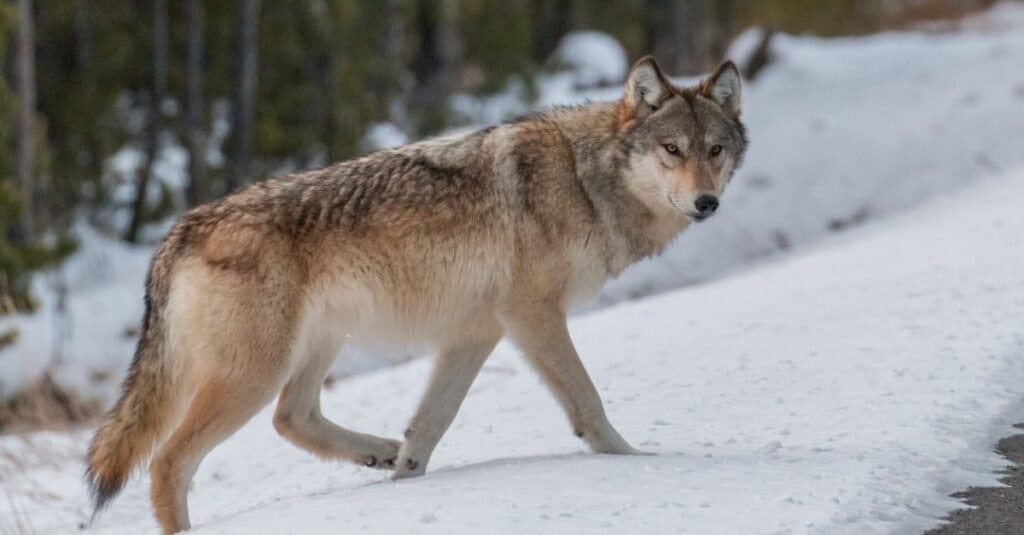Wolves are some of the most unique animals in the world, with their elusive nature and strict pack hierarchy. Wolves inhabit 13 states across the United States, with the majority living in Alaska. Although wolves were once much more widespread across the country, they were hunted almost to extinction in some places. So, with that in mind, let’s discover everything you need to know about wolves in Michigan, including their history and where they live.
Where Do They Live?
Wolves are highly adaptable animals and live in a wide variety of habitats, including forests, mountains, and grasslands. Michigan has a diverse topography and a wide range of areas that are suitable for wolves. However, wolves only inhabit Michigan’s Upper Peninsula and are completely absent from the Lower Peninsula.
The Upper Peninsula spans around 16,500 square miles, and wolves inhabit approximately 90% of it. The Upper Peninsula is largely covered with thick forests, although it also features several mountainous regions. These remote habitats provide wolves with plenty of cover while also offering an abundance of prey.
Isle Royale

Isle Royale is an island in Lake Superior that is home to around 30 of Michigan’s wolves.
©iStock.com/Posnov
Although gray wolves inhabit the majority of Michigan’s Upper Peninsula, they also inhabit another area of the state — Isle Royale. Isle Royale is an island in the Michigan region of Lake Superior, which is the largest lake in the world by area. Isle Royale is the third-largest island in the contiguous United States, being nine miles wide and with a length of 45 miles. The entire area is within the Isle Royale National Park, which also includes many smaller islands nearby.
Wolves on Isle Royale are believed to have traveled to the island when an ice bridge formed in 1948 between the island and Canada. Wolves have inhabited the island ever since. However, like the wolves in the rest of the state, their population has faced its fair share of challenges. Despite a high of 50 wolves at one point, the population was down to just two individuals by 2018. These two wolves were inbred and unable to reproduce.
Although the end of wolves on Isle Royale seemed imminent, a recovery mission was undertaken which involved catching wolves from the Upper Peninsula and nearby states and relocating them to the island. In total, around 30 wolves were added to Isle Royale, and they have since successfully produced several litters of cubs.
The Isle Royale wolves play a vital role, though, as they actually serve to keep the island’s moose population in check. Without the wolves, the moose are at risk of starvation due to overbrowsing. However, the addition of the wolves means that the predator-prey balance can be restored and the moose population remains under control, allowing the vegetation chance to recover.
How Many Wolves Are There in Michigan?

Michigan now has a stable population of wolves, although this was not always the case.
©AB Photographie/Shutterstock.com
There are currently approximately 660 wolves in Michigan, including the population of Isle Royale wolves. Around 630 wolves inhabit the Upper Peninsula, although anything between 600 and 700 is within the normal population size.
However, wolves weren’t always in such a good position in the state. In 1938, the number of wolves in the Lower Peninsula was already in decline, and at this point, a bounty was established to control the remaining population. Over the next century, wolves in Michigan were regularly shot or poisoned. By 1910, they were completely absent from the Lower Peninsula, with packs remaining only in the Upper Peninsula. Numbers continued to decline, though, and by the 1960s the population in the Upper Peninsula was down to single figures, and the government bounty was removed.
Wolves became a protected species in Michigan in 1965 and were classified as Endangered across the United States in 1974. Reports are conflicted as to how many wolves remained in the state, with some suggesting they were completely extirpated and others assuming that a small number remained.
Whether or not wolves were completely gone from the state, what is known is that wolves in neighboring Wisconsin gradually began to move across the border, allowing the population to re-establish in Michigan. The first new wolf cubs were born in the state in 1991, and by 1992, the Michigan Department of Natural Resources was able to confirm that there were 20 wolves living in the state. It has been a slow but steady recovery since then, with more packs establishing across the Upper Peninsula until they’ve reached today’s stable population.
What Do Wolves Eat?

Gray wolves prey predominantly on large mammals, such as moose and deer.
©Daniel Korzeniewski/Shutterstock.com
Wolves are carnivores, which means that the majority of their diet consists of meat. Wolves are apex predators, meaning that they are at the top of the food chain without any natural predators of their own. Gray wolves typically prey on large mammals, such as moose, deer, and elk.
Wolves are powerful predators, and gray wolves weigh between 60 and 175 pounds, meaning that they are easily capable of taking down large prey animals. Wolves often hunt in packs, working together to surround and kill their chosen prey, making them even more formidable. As well as increasing their chances of a successful hunt, working in a pack also reduces the risk of the wolves getting injured or even killed in the process.
Although large prey animals are the preferred choice of wolves, if they are not readily available then wolves will often turn to smaller animals, such as rodents and birds, and even, in rare circumstances, plants.
Are They Dangerous?

Wolves are not typically dangerous to humans.
©iStock.com/mtnmichelle
Despite wolves being apex predators they are not typically considered to be dangerous to humans. Although there is still a very small risk that one may attack if it is cornered or provoked, the chance of being attacked by a wolf in Michigan is close to zero. Although there are occasions where they have attacked people in other areas across North America, there are no documented attacks on humans in the state. However, there have been a handful of incidents where they have attacked domestic animals and livestock.
Typically, wolves are scared of people. They are highly elusive and shy animals and will usually avoid conflict. However, if you do encounter a wolf then it is advised to never run away. Instead, you should stand tall and back away slowly.
As a federally protected animal, it is currently illegal to kill or injure a wolf unless it is directly threatening a person. However, Michigan has long been embroiled in a debate as to whether to allow the hunting of wolves should they become delisted.
Advocates for the hunting of wolves believe that the risk to livestock and domestic animals justifies the killing of them. Furthermore, they argue that wolves are having an effect on the population of other game species, such as deer, making them less available for the hunting season.
The other aspect of the debate argues that wolf-deterrent methods should be used to prevent livestock predation instead of taking more drastic steps. Deterrents such as noise and light are effective at scaring away wolves, while some farmers have also turned to the use of livestock guardian animals, such as llamas and donkeys.
The photo featured at the top of this post is © slowmotiongli/Shutterstock.com
Thank you for reading! Have some feedback for us? Contact the AZ Animals editorial team.







